List of Authors
>>About this blog
Recent blog post
|
[Sam]
April 22, 2015 14:00
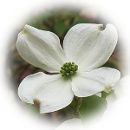 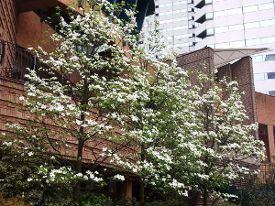 April 20 was "grain rain" in twenty-four season old calendar. April 20 was "grain rain" in twenty-four season old calendar.
This is the season when rice fields and fields are ready and spring rain encourages grain sprout.
At Harumi Triton Square's Flower Terrace, a new horticultural variety from dogwood, White Love, is at its best.
dogwood (also known as yamaboshi) is a deciduous Takagi of the genus mizuki native to North America.
Prior to the development of the leaves, the canopy is covered with flowers with four petal-shaped bracts, giving a more elegant impression than Japanese dogwood, which is close to domestic native species.
By the way, the real flowers of dogwood are yellow-green grains in the center of the four bracts.
dogwood's total bracts are distinguished from Japanese dogwood.
"White Love" is a neat tree shape with an uprightness compared to native species, and the flowers are large and good with flowers.
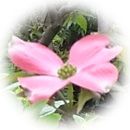 If you turn your eyes, the dogwood "Cherokey", which is also planted on the "Flower Terrace", is also blooming. If you turn your eyes, the dogwood "Cherokey", which is also planted on the "Flower Terrace", is also blooming.
This is a red flower variety.
Compared to neat white flower varieties, it has a warm and gentle impression and an elegant flower shape.
By the time the total bracts are scattered, they are attached to young rice grains.
The fruits grow little by little in the shade of leaves during the summer, and when cool, they turn red as if they could not wait.
The autumn leaves are also wonderful.
dogwood enjoys flowers, autumn leaves, and fruits in each of the four seasons, and is popular as a flower tree with three beats of flowers, leaves, and fruit.
[Sam]
April 15, 2015 18:00
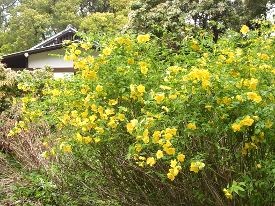 In Hamarikyu Onshi Garden, from April 1 to May 16, in order to let the inhabitants of the ward know the splendor of the garden, the ward will bring the admission numbered ticket posted on the "Chuo-ku homepage / ward news" This year, residents of the city are conducting a “Flower and Green Gathering” that can be entered for free. In Hamarikyu Onshi Garden, from April 1 to May 16, in order to let the inhabitants of the ward know the splendor of the garden, the ward will bring the admission numbered ticket posted on the "Chuo-ku homepage / ward news" This year, residents of the city are conducting a “Flower and Green Gathering” that can be entered for free.
Following the Yoshino cherry tree, which was in full bloom at the end of last month, a group of so-called Yae-zakura, which is planted on the shores of the pond, from the Oden Bridge to the Kaiden Bridge in the Shioiri Pond, tend to attract attention. One of them is Yamabuki, beside the rest area of Hanakien.
The flower is known to have become one of the color names.
It is a deciduous shrub of the genus Japan globeflower, belonging to this species only.
Although it is a familiar flower figure, it has been popular for a long time and is one of the spring seasonal words.
The soft young green leaves and the bright yellow flower-colored appearance create warmth and signal the arrival of spring.
Japan globeflower's name is derived from "Yamashin," which expresses the appearance of a supple branches swaying in the wind.
In addition to single blooming, in addition to double-flowered (Yaezakiyamabuki) and chrysanthemum (Kikuzakiyamabuki), you can see white flowers (Shirobanayamabuki).
As a tea flower, the branches mixed with buds are used as "attached" as a treatment that adjusts the overall balance and creates a sense of season, and as "root tightening" to tighten the roots of inserted flowers and branches, etc. I hear that it is used.
Apart from the 5-valve Japan globeflower, there are 4-valve leaves, which are opposite to alternate leaves, but this is a separate genus (Rosaceae).
The leaf surface of Shiroyamabuki has deep wrinkles, and the edges are rough. These leaves serve as borders to enhance the white flowers, giving you a different neatness from Japan globeflower.
In addition, there is yamabukiso, which has flowers similar to Japan globeflower, but this is the genus Kusano.
    
From the left, Japan globeflower, Yae Japan globeflower, Kikuzakiyamabuki, Shirobanayamabuki, Shiroyamabuki, Shiroyamabuki
[Sam]
April 12, 2015 14:00
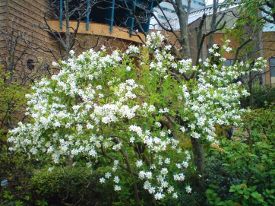 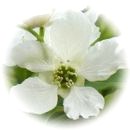 "I'm laughing!" It is the shape of a peaceful and bright spring mountain where the vegetation has begun to grow. "I'm laughing!" It is the shape of a peaceful and bright spring mountain where the vegetation has begun to grow.
April 5th is Kiyoaki of twenty-four season old calendar. It is the season when everything is full of fresh and bright air.
"Harumi Triton Garden" is also a season when trees bud and soft green "laughing" plants can be seen.
The annual "Mini Garden Guide Tour" takes a walk around the park with the guidance of a green advisor at the hotel pocket plaza "Flowers, Water and Trees". The theme of this event held on April 9 is "Spring is full! Flowers and bulbs".
The first thing that catches your eye on the "Flower Terrace" is "Ricyubai (Rikyu Ume)".
A deciduous shrub of the family Rosaceae native to China.
At the tip of the branch, 6-10 pure white neat five-petaled flowers are attached to the whole shape at the same time as the young leaves, and resembles plums,deutzia Umezaki (Umesaki Soraki).
I hear that tea flowers are often used as buds or branches that are beginning to bloom to adjust the overall balance and create a sense of the season.
Then a little fury-colored flowers.
Flannel flower of the family Celebra family while similar to a chrysanthemum with a texture like a white felt, Mugiwaragiku, whose crisp flowers are suitable for dried flowers, delicate leaves and supple trees, rare camellia "Elina", a rare camellia with pale pink florets 3 kinds of euphorvia with a unique shape of a cup-shaped inflorescence ...
Then, following the Pansy & Viola Collection 2014/2015, about 100 new species of Tulip Collection 2015.
Tulip is a representative bulb plant of the genus Liliaceae.
The flower color is extremely abundant and the flower shape is also unique.
Early / middle / late / late / ancestor, single / Yae, lily / perlot bloom (parlot means parrot). The petals are wavy and cut into the edges) / Fringe bloom (the tip of the petals is jagged) / Changing bloom, and it can be enjoyed greatly.
    
From the left, Mary Christmas, Aladdin, Hermitage, Sensal Touch, Apricot Beauty
    
From left, Sweetheart, Exotic Sun, Shirley, Silver Perlot, Ice Wonder
[Sam]
April 6, 2015 16:00
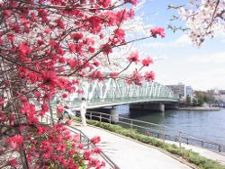 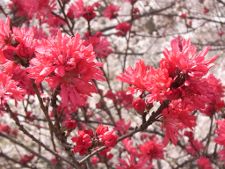
 Ishikawajima Park is located along the Sumida River school river from Chuo-ohashi Bridge to the south of Aioi Bridge. The adoption of Super dike ensures hydrophilicity so that it can interact with water, and cherry blossoms are planted on the dike, which is crowded with jogging, strolling, and walking dogs. Ishikawajima Park is located along the Sumida River school river from Chuo-ohashi Bridge to the south of Aioi Bridge. The adoption of Super dike ensures hydrophilicity so that it can interact with water, and cherry blossoms are planted on the dike, which is crowded with jogging, strolling, and walking dogs.
This time, "Kikumomomo" (also known as Genjiguruma), which is planted in the square in front of Aioi no Sato, a complex on the southwest side of Aioi Bridge at the southern end of Ishikawajima Park.
The peaches of the deciduous Odaka tree belonging to the family Rosaceae are broadly divided into "Mimomomo", which treats fruits as edible fruit trees, and "Hana Momo", a horticultural variety that treats flowers as flowering trees.
The "Terute" series (Terute red, Terute white, Terute peach, Terute princess) is a broom-shaped tree-shaped double-flowered with abundant flower colors, "Yaguchi" with pink double-flowered pink, pink, red, and spots (squeezed) from a single tree.
Before giving out the leaves, it is wonderful that chrysanthemum flowers bloom so tightly that they cover the branches.
[Sam]
April 5, 2015 18:00
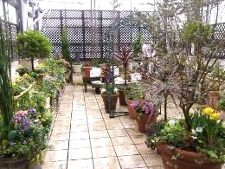 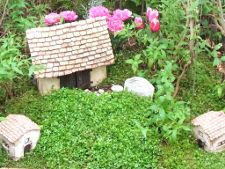
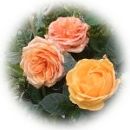 On April 3, at the Royal Room on the 10th floor of FANCL Ginza Square (Ginza 5), the first garden event in the 2015 season, "Spring Flower Garden" produced by Masayo Imai, will begin. On April 3, at the Royal Room on the 10th floor of FANCL Ginza Square (Ginza 5), the first garden event in the 2015 season, "Spring Flower Garden" produced by Masayo Imai, will begin.
Date: April 3 (Fri)-10 (Fri) 11:30-18:30
It was opened to the public as "Rose Garden" in 2008, and now seven garden events are held a year.
During the exhibition, works of a general application container garden planted with the theme of "temptation of flowers" will also be exhibited.
The terrace, where warm and soft sunlight pours, is full of colorful spring flowers with elaborate designs.
In the hall, "GINZA SPRING MUSE FAIR" is being held to celebrate the season when new life sprouts.
The schedule of future garden events is as follows.
・Spring Rose Garden (May 22-29)
・Hydrangea Garden in early summer (June 12-19)
・Summer Cool Beauty Terrace (August 2)
・Fruitful Autumn Garden (October 2-9)
・Autumn Rose Garden (October 30-November 6)
・Christmas illumination garden (December 14-December 20)
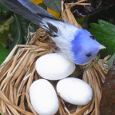 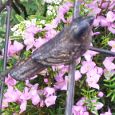 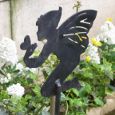 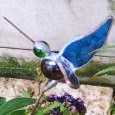
    
[Sam]
April 4, 2015 14:00
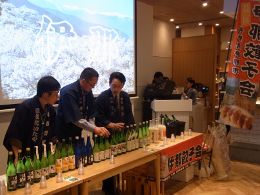 On April 1st (Wednesday), at Ginza NAGANO (Ginza 5), "Sakura Full Bloom! Ina Arata Tani Sake Festival in Ginza" was held. On April 1st (Wednesday), at Ginza NAGANO (Ginza 5), "Sakura Full Bloom! Ina Arata Tani Sake Festival in Ginza" was held.
In addition to serving as a PR for the annual Ina Arata Tani Sake Festival (scheduled to be held on April 11 this year) held at Kasuga Castle Ruins Park, a famous cherry blossom spot overlooking Ina City, a comparison of eight sake brewery young sake in Inaya, as well as a taste of Inaya's specialty sake appetizers and delicacies.
Inaya has eight unique Japanese sake brewery, each with a deep taste of sake, as well as three local beer, whiskey and wine breweries.
This time, it was a fun evening to listen to the commentary of Mr.
・Mr. Satoshi Miyajima, President of Shinano Nishiki
・Mr. Masahiko Urushido, President of Inokashira
・Mr. Shuji Nakamura, owner of Ida liquor store
We also received Ina's specialty “Inago” and “Sericulture Pup”, which are now high-quality ingredients.
<Today's Sake>
・Shinano Nishiki "Intelligible Muchakumukutoku" aromatic filtration raw sake
・Shinano Nishiki "Shikuro Shibori-Tate" Special Junmai Sake
・Shinano Nishiki "Pure Ama Sake / Brown Rice Ama Sake" (non-alcoholic)
・Inokashira "Jure rice freshly squeezed unfiltered sake"
・Kuromatsu Senjo "Junmai Ginjo Direct Pumping Raw undiluted sake"
・The Great Powerhouse "Junmai Miyama Nishiki" Fire
・Shinano crane "Pure Rice Unfiltered undiluted sake"
・"Junmai Ginjo student undiluted sake"
・Kikusui "Spring Hitohira" Burning honjozo
・Kikusui "Mt. Hijiri", Ginjo student undiluted sake
・Before dawn, Junmai Ginjo Unfiltered undiluted sake
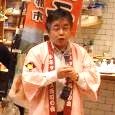  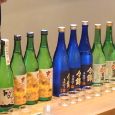 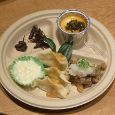
1
|
Links
|
 April 20 was "grain rain" in twenty-four season old calendar.
April 20 was "grain rain" in twenty-four season old calendar.If you turn your eyes, the dogwood "Cherokey", which is also planted on the "Flower Terrace", is also blooming.




































